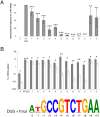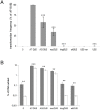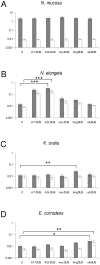Dialects of the DNA uptake sequence in Neisseriaceae
- PMID: 23637627
- PMCID: PMC3630211
- DOI: 10.1371/journal.pgen.1003458
Dialects of the DNA uptake sequence in Neisseriaceae
Abstract
In all sexual organisms, adaptations exist that secure the safe reassortment of homologous alleles and prevent the intrusion of potentially hazardous alien DNA. Some bacteria engage in a simple form of sex known as transformation. In the human pathogen Neisseria meningitidis and in related bacterial species, transformation by exogenous DNA is regulated by the presence of a specific DNA Uptake Sequence (DUS), which is present in thousands of copies in the respective genomes. DUS affects transformation by limiting DNA uptake and recombination in favour of homologous DNA. The specific mechanisms of DUS-dependent genetic transformation have remained elusive. Bioinformatic analyses of family Neisseriaceae genomes reveal eight distinct variants of DUS. These variants are here termed DUS dialects, and their effect on interspecies commutation is demonstrated. Each of the DUS dialects is remarkably conserved within each species and is distributed consistent with a robust Neisseriaceae phylogeny based on core genome sequences. The impact of individual single nucleotide transversions in DUS on meningococcal transformation and on DNA binding and uptake is analysed. The results show that a DUS core 5'-CTG-3' is required for transformation and that transversions in this core reduce DNA uptake more than two orders of magnitude although the level of DNA binding remains less affected. Distinct DUS dialects are efficient barriers to interspecies recombination in N. meningitidis, N. elongata, Kingella denitrificans, and Eikenella corrodens, despite the presence of the core sequence. The degree of similarity between the DUS dialect of the recipient species and the donor DNA directly correlates with the level of transformation and DNA binding and uptake. Finally, DUS-dependent transformation is documented in the genera Eikenella and Kingella for the first time. The results presented here advance our understanding of the function and evolution of DUS and genetic transformation in bacteria, and define the phylogenetic relationships within the Neisseriaceae family.
Conflict of interest statement
The authors have declared that no competing interests exist.
Figures





Similar articles
-
Natural competence and the evolution of DNA uptake specificity.J Bacteriol. 2014 Apr;196(8):1471-83. doi: 10.1128/JB.01293-13. Epub 2014 Jan 31. J Bacteriol. 2014. PMID: 24488316 Free PMC article. Review.
-
Functional analysis of the interdependence between DNA uptake sequence and its cognate ComP receptor during natural transformation in Neisseria species.PLoS Genet. 2013;9(12):e1004014. doi: 10.1371/journal.pgen.1004014. Epub 2013 Dec 19. PLoS Genet. 2013. PMID: 24385921 Free PMC article.
-
Restriction and sequence alterations affect DNA uptake sequence-dependent transformation in Neisseria meningitidis.PLoS One. 2012;7(7):e39742. doi: 10.1371/journal.pone.0039742. Epub 2012 Jul 2. PLoS One. 2012. PMID: 22768309 Free PMC article.
-
Identification of integrative and conjugative elements in pathogenic and commensal Neisseriaceae species via genomic distributions of DNA uptake sequence dialects.Microb Genom. 2020 May;6(5):e000372. doi: 10.1099/mgen.0.000372. Epub 2020 May 4. Microb Genom. 2020. PMID: 32375974 Free PMC article.
-
Silently transformable: the many ways bacteria conceal their built-in capacity of genetic exchange.Curr Genet. 2017 Jun;63(3):451-455. doi: 10.1007/s00294-016-0663-6. Epub 2016 Nov 8. Curr Genet. 2017. PMID: 27826682 Review.
Cited by
-
Natural competence and the evolution of DNA uptake specificity.J Bacteriol. 2014 Apr;196(8):1471-83. doi: 10.1128/JB.01293-13. Epub 2014 Jan 31. J Bacteriol. 2014. PMID: 24488316 Free PMC article. Review.
-
Functional analysis of the interdependence between DNA uptake sequence and its cognate ComP receptor during natural transformation in Neisseria species.PLoS Genet. 2013;9(12):e1004014. doi: 10.1371/journal.pgen.1004014. Epub 2013 Dec 19. PLoS Genet. 2013. PMID: 24385921 Free PMC article.
-
The role of apolipoprotein N-acyl transferase, Lnt, in the lipidation of factor H binding protein of Neisseria meningitidis strain MC58 and its potential as a drug target.Br J Pharmacol. 2017 Jul;174(14):2247-2260. doi: 10.1111/bph.13660. Epub 2016 Dec 21. Br J Pharmacol. 2017. PMID: 27784136 Free PMC article.
-
Costs and benefits of natural transformation in Acinetobacter baylyi.BMC Microbiol. 2017 Feb 15;17(1):34. doi: 10.1186/s12866-017-0953-2. BMC Microbiol. 2017. PMID: 28202049 Free PMC article.
-
Kingella kingae: carriage, transmission, and disease.Clin Microbiol Rev. 2015 Jan;28(1):54-79. doi: 10.1128/CMR.00028-14. Clin Microbiol Rev. 2015. PMID: 25567222 Free PMC article. Review.
References
-
- Thomas CM, Nielsen KM (2005) Mechanisms of, and barriers to, horizontal gene transfer between bacteria. Nat Rev Microbiol 3: 711–721. - PubMed
-
- Johnsborg O, Eldholm V, Havarstein LS (2007) Natural genetic transformation: prevalence, mechanisms and function. Res Microbiol 158: 767–778. - PubMed
-
- Majewski J (2001) Sexual isolation in bacteria. FEMS Microbiol Lett 199: 161–169. - PubMed
-
- Tortosa P, Dubnau D (1999) Competence for transformation: a matter of taste. Curr Opin Microbiol 2: 588–592. - PubMed
Publication types
MeSH terms
Substances
LinkOut - more resources
Full Text Sources
Other Literature Sources
Molecular Biology Databases

